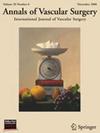Cerebral Hyperperfusion Syndrome after Carotid Revascularization; Predictors and Complications
IF 1.4
4区 医学
Q3 PERIPHERAL VASCULAR DISEASE
引用次数: 0
Abstract
Background
Cerebral hyperperfusion syndrome (CHS) is a rare but serious complication following carotid artery revascularization. Considering the varying rates observed among carotid endarterectomy (CEA), Transfemoral Carotid Artery Stenting (TFCAS), and Transcarotid Artery Revascularization (TCAR), identifying the predictors and complications of CHS is essential for improving patient outcomes. This study utilizes a national database to investigate the predictors and complications of CHS following carotid revascularizations.
Methods
We conducted a retrospective analysis of all patients undergoing CEA, TFCAS, and TCAR for carotid artery stenosis in the Vascular Quality Initiative database from 2020 to 2023. Multivariate logistic regression was applied to identify CHS predictors, which were used to develop a risk score calculator. Moreover, we compared the stroke and mortality rates following CHS among the 3 revascularization techniques.
Results
The final cohort in our study included 59,130 (53%) CEAs, 14,064 (13%) TFCAS’s, and 37,565 (34%) TCARs. There were 281 cases of CHS (0.25%), and TFCAS was associated with the highest rate of CHS (0.78% vs. 0.22% vs. 0.15%; P < 0.001). After adjusting for potential confounders, TFCAS was associated with almost 3-fold higher risk compared to CEA (adjusted odds ratio (aOR) = 2.87 [95% confidence interval (CI): 1.65–4.9] P < 0.001). On the other hand, TCAR was comparable to CEA. Other predictors of CHS included uncontrolled hypertension, insulin-dependent diabetes, symptomatic status, prior carotid procedure, urgent intervention, and postoperative blood pressure medication. These predictors were used to develop an interactive CHS risk calculator (C-statistic = 0.8). Among patients who developed CHS, TFCAS was associated with a 70% higher risk of inhospital stroke (aOR = 1.7 [95% CI: 1.4–2] P < 0.001) and almost triple the risk of inhospital death (aOR = 2.9 [95% CI: 2.3–3.8] P < 0.001). TCAR and CEA were comparable except for a slight risk of inhospital stroke after TCAR (aOR = 1.2 [95% CI: 1–1.3] P = 0.03).
Conclusion
In this multi-institutional national study, we have demonstrated that the type of carotid revascularization significantly influences the risk of CHS and subsequent stroke and mortality, with TFCAS associated with the highest risk. Uncontrolled hypertension was associated with a 2-fold increased risk of CHS, underscoring the importance of tight blood pressure control. We were able to provide a prediction model for CHS based on preoperative factors. Prospective use of this risk calculator might benefit in postoperative monitoring.
求助全文
约1分钟内获得全文
求助全文
来源期刊
CiteScore
3.00
自引率
13.30%
发文量
603
审稿时长
50 days
期刊介绍:
Annals of Vascular Surgery, published eight times a year, invites original manuscripts reporting clinical and experimental work in vascular surgery for peer review. Articles may be submitted for the following sections of the journal:
Clinical Research (reports of clinical series, new drug or medical device trials)
Basic Science Research (new investigations, experimental work)
Case Reports (reports on a limited series of patients)
General Reviews (scholarly review of the existing literature on a relevant topic)
Developments in Endovascular and Endoscopic Surgery
Selected Techniques (technical maneuvers)
Historical Notes (interesting vignettes from the early days of vascular surgery)
Editorials/Correspondence

 求助内容:
求助内容: 应助结果提醒方式:
应助结果提醒方式:


